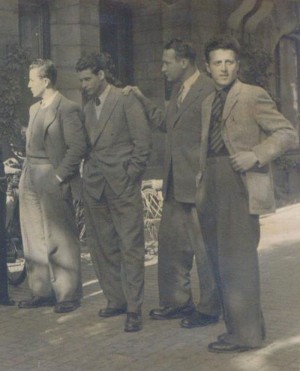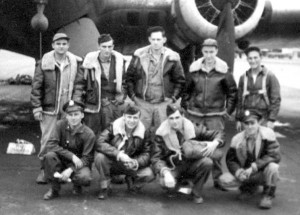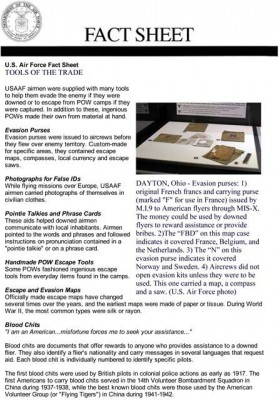03 Jun Escape and Evasion into Sweden
Shortly after my father, Herman F. Allen’s B-17, Liberty Lady, crash landed in neutral Sweden, he was interned in the city of Rättvik. After only a month, because he knew how to type, he was recruited to go to Stockholm to work in the office of Col. Felix Hardison, the Military Air Attaché. It was April of 1944.
As the bombing missions were flying deeper and deeper into Nazi Germany, more and more pilots of badly damaged planes would divert their crews to Sweden, praying that they would arrive alive.
My Dad was one of the men from Hardison’s office who would meet the crash, take care of the injured, and send the rest of the crew on to one of the internment camps.
Sweden was neighbor to the countries of Denmark and Norway, both occupied by the Germans. The British and the Americans in Stockholm provided much support to their underground resistance forces. When an Allied plane would be forced to land there, or worse yet have to parachute out, the locals would risk their lives helping the men escape to Sweden.
All in all, fifty Americans arrived in Sweden from Denmark, nine from Norway.
Whenever this happened, the men who had escaped or evaded capture would be taken to the American Legation in Stockholm to be questioned by Col. Hardison and his aides, one of which was my father.
Thanks to a discussion on the Facebook page, American Internees in WWII Sweden, and at the suggestion of military historian Dwight Mears, I discovered the National Archive’s collection of Escape and Evasion reports. Those from Stockholm are included, and I was able to find reports of men who had been questioned by none other than Herman F. Allen.
The first one evader he worked with was 2nd Lt. Robert R. Kerr with the 303rd Bomb Group flying out of Molesworth, England. He was co-pilot of the Howard J. Bohle crew. On 29 April 1944, their target was Berlin.
2nd Lt. Kerr’s personal narrative described what happened that day.
Over the target, their B-17, the Spirit of Wanette (#42-31241), encountered heavy flak which knocked out the #4 engine. There was a severe gas leak in the No. 3 tank. Pilot 2nd Lt. Howard J. Bohle, feathered the engine, but the gas remaining was insufficient to take them back to England. He asked the navigator, 2nd Lt. John K. Brown, for a heading to Sweden.
They crossed the Baltic Sea and saw land through a hole in the clouds. At the same time, an ME 120 attacked the plane. It was shot down by the tail gunner, Sgt. M. Musashe, but must have radioed the ship’s position to the antiaircraft batteries because a barrage of flak was shot up. The plane was hit square, knocked out the #2 engine. The flight control cables were severed. The pilot could not recover control, so he ordered the crew to bail out.
When Kerr landed in an open field, he noticed a young boy watching him. Kerr asked him if this was “Svenske.” The boy replied, no, that it was “Danske,” and the Germans were close.
For the next several days, Kerr was assisted by members of the Danish Underground. He was taken to a harbor near the city of Copenhagen where he was joined by nine Danes who were escaping also. One was a young man of about 21 who had been condemned to death and had escaped from a prison near the city.
They boarded a small fishing boat and waited until 0620 hours when they proceeded cautiously from the harbor, avoiding German patrol boats and planes in the vicinity.
At 1000 hours, they were in international waters, within sight of Malmo. A Swedish fishing boat took them to shore. The group was taken to the police station where Kerr was separated from the Danes, interrogated, given a medical examination and ration coupons. He was then taken to the American Consulate office.
“I departed for Stockholm Wednesday night, arriving there 0758 hours, 11 May 1944. Lt. Herman F. Allen, of the Military Air Attaché office, met me at the station.”
It is a thrill for me to finally find documentation of the work my father was doing in Stockholm for the Military Air Attaché. I’ve heard about it, but this is the first airman interrogation report I’ve seen.
The last minutes of the Spirit of Wanette were so close to what could have happened to my Dad’s B-17, Liberty Lady. Both planes were over Berlin, hit by heavy flak and had engines knocked out. Both flew over the Baltic Sea, headed for Sweden. When the Liberty Lady landed, the crew feared they were in Denmark. Thankfully, they were not.
Kerr said that he was informed by local residents that four of his crew members were seen in custody of the Germans. That would have been Pilot 2nd Lt. Howard J. Bohle, Navigator 2nd Lt. John K. Brown, Bombardier 2nd Lt. Joseph J. Nevills, and Top Turret Gunner S/Sgt. Lawrence W. Rice. All went to POW camps.
The residents also told him that three men “were in the water and unable to get out.” Actually, there were four. Radio Operator S/Sgt. Henry Jensen, Ball Turret Gunner Sgt. John Derschan, Waist Gunner Sgt. Frank Gorgon and Sgt. Paul J. Mulhearn landed in the sea and drowned. Their bodies washed up on shore and were recovered.
S/Sgt. Michael Musashe was killed by the flak burst and crashed with the plane. The 303rd BG mission report states that the plane crashed in the Sea of Smaland, Denmark. He is officially an “MIA.”
Airmen DK – Allied Airmen in Denmark
I found an amazing website that chronicles each Allied airman that landed in Denmark during the war. You can read each account in Danish and in English. Plus, there are maps that show where each crew member went down. These would be invaluable for a family member who might want to go to Denmark in honor of their relative who died there. I know it’s what I would want to do.
The Interrogation
When Herman Allen questioned 2nd Lt. Kerr, the first thing he would have asked for was a recounting of the crew’s mission. “Describe everything that happened in the plane before the jump.”
I am sure that when my father heard 2nd Lt. Kerr’s story, he realized just how close his own crew had come to suffering a similar fate.
2nd Lt. Kerr was back in England on May 28th. According to article 13 of the Hague Convention (V) of 1907, “A neutral Power which receives escaped prisoners of war shall leave them at liberty.” Instead of being interned, the practice in Sweden was for those who had escaped or evaded capture to be sent back to their bases as quickly as practically possible.
Once Kerr was back in London, the questions continued at RAF Intelligence Headquarters. He remembered this as an office located in an old building in central London, several levels below the street.
The details given were important. “List all military information which you observed or were told while evading. Give fullest possible details. (Airfields, troop encampments, coastal and interior defenses, AA batteries, radar installations, troop movements, results of allied bombing, location of enemy factories and ammunition dumps, enemy and civilian morale, etc. etc.)”
Who helped them? Where did they go and how? Certain information could be used in future classes taught to the airmen back at their bases. Other specifics would show how well the underground resistance movement was working. How dangerous or how safe were certain parts of the country? Examples of comments made by the interrogators:
- Notice how closely the German searchers followed the evaders and the great risks run by the helpers.
- Good advice on seeking out doctors and ministers in Denmark
- Informants were told that most of the Germans on Bornholm are in the NW part of the island.
Escape Kits
Every airman was issued an escape kit, often a small plastic box carried in a leg pocket of the flight coveralls. Once safely in Stockholm, they were given a questionnaire: “Suggestions for improvement of escape equipment and training come largely from those who make use of them. Your report and comments will help others to evade capture or to escape.” 2nd Lt. Kerr didn’t use his aids box, he wrote, but other airmen’s reports had great suggestions, such as:
- Chocolate bar good. Peanut bar is no good.
- Compass: used it to navigate to Sweden by.
- How did you spend the money? Denmark – for passage to Sweden
- Suggestions you think will help other evaders and escapers? The phrase card was absolutely no use since it only had French, German, Dutch and Spanish. The people in Denmark speak Danish.
- Take an extra pair of woolen socks.
- Did you pay your guides? If so, how much? Watch and ring.
Each airman had to sign a document swearing that he would not talk with anyone about his experiences. “Publication or communication to any unauthorized persons of experiences of escape or evasion from enemy-occupied territory, internment in a neutral country, or release from internment not only furnishes useful information to the enemy but also jeopardizes futures escapes, evasions and releases.”
This has been a long post, but I wanted to pay tribute to this crew whose final day in the skies over Nazi Germany started out so much like that of my Dad’s. One extra German fighter, a few more bursts of flak, and the men of the Liberty Lady could easily have had the same fate.
You can read more about Robert R. Kerr in the 2002 book, The Lucky Ones: Airmen of the Mighty Eighth by Erik Dyreborg. Kerr narrates the chapter titled, “The Long Walk Back from the Last Mission.”
We can never thank our veterans enough.





Barbara davis
Posted at 05:31h, 05 JuneGreat story and information! Love the photograph of Herman. Had not seen before.